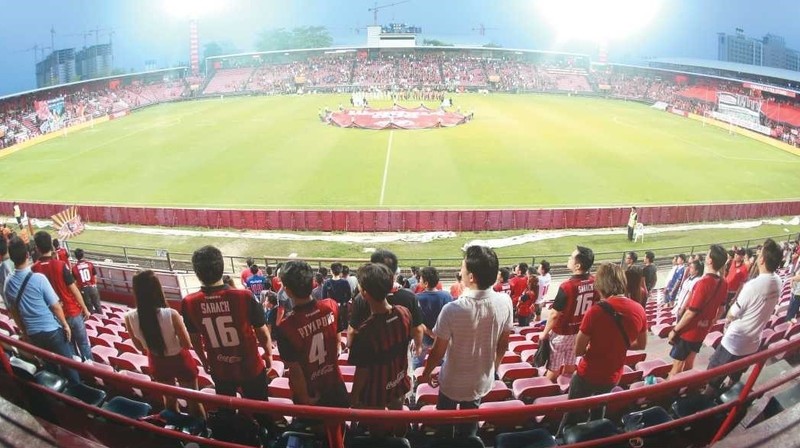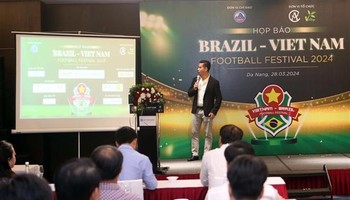Below is a story about the recent visit made by Duong Minh, a Nhan Dan Monthly reporter, to Thailand in order to explore how the land of golden temples has been developing its football.
Self-esteem of the Thai
As the saying goes, a strong national football team must be assembled from a developed football league and the top-tier league of a nation is considered a measurement for its football development. The Thai professional football league, known as the Thai Premier League, officially came into existence in 1996. With its ailing development at that time, the tournament was not appealing enough to home fans as well as local footballers, with many Thai football stars such as Kiatisak, Thonglao, Isawa, Dusit and Tawan choosing Vietnam as a place to develop their football careers. In the 2000s, Vietnam’s V-League was considered the most interesting domestic tournament in Southeast Asia and a promised land for Thai players, which drove Thai media to send a group of reporters to Vietnam for further understanding of the country’s football development.
“Our league was previously quite amateur as Thai clubs did not have their own stadiums and players had yet to see football as a profession. The country’s leading stars at that time decided to play for Vietnamese clubs, which made the Thai football sphere determined to organise a quality tournament like the V-League,” Teerasil Dangda, who is playing for the SCG Muangthong United FC, said while talking with us.
The weak self-esteem of the Thai people was also understandable as their national team had been dominating the region but the quality of their domestic tournament was not as good as that of neighbouring countries. For that reason, the Thai football sphere looked towards nations with the top tournaments in the world for lessons, and the Premier League model has been thoroughly applied by Thai people since they embarked on reform in 2006.
During my last days in Bangkok watching the last rounds of the 2015 Thai Premier League, I had a feeling that I had been watching the Premier League. It was also like the top-tier leagues of Japan or the Republic of Korea (RoK), especially the excitement from the stands.
The V-League was once the top tournament in the region; however, since the Thai built the Thai Premier League nearly 10 years ago, it has exceeded the V-League in many aspects.
Changing ways of thinking and doing
There is a pragmatic but realistic truth about professional football: a strong team is a team with a lot of money, and this is being fully realised by clubs playing in the Thai Premier League. For instance, SCG Muangthong United, the runner-up of the 2015 Thai Premier League, has been flourishing since being financially backed by the Siam Cement Group (SCG) in 2012. It was a seismic event in the history of Thai football at that time as the SCG invested THB600 million (US$16.75 million) in Muangthong United within five years, thereby becoming the club’s major sponsor with 30% of shares.
Alongside funding from key sponsors, Thai clubs also sought other sub-sponsorships and used them to add excitement to warm-up activities ahead of Thai Premier League matches with entertainment and sports items, which not only draws more audience to the stadium but also bring about considerable profits.
Present at the SCG Stadium to watch the last 2015 Thai Premier League match between SCG Muangthong United and Nakhon Rachasima, what I liked the most was a system of stores selling the host team’s range of products around the stadium. Although these products were not cheap at all, with a shirt selling for VND400,000-VND1 million (US$18-45) depending on materials, they still attracted a lot of buyers. According to Yunttang Jiamtragan, Vice President of the SCG, Muangthong United earns between THB75-80 million (US$2.1-2.23 million) in revenues from selling products each year, which is equivalent to the operational funding for a V-League club in the whole year.
“If only local supporters in Vietnam are dressed in their clubs’ jerseys in each of their favourites’ match, V-League teams would have a remarkable source of revenues to cover their operation,” said President of Becamex Binh Duong FC Nguyen The Huan, who accompanied us on our visit to Thailand. However, in a football environment favouring “give and present” rather than purchasing, and preferring cheap counterfeiters to genuine products as in Vietnam, it is really difficult for Huan’s dream to come true.
Answering our queries about how the Thai Premier League could achieve this level of development in such a short time, Teerasil Dangda, a footballer of Muangthong United, said that big steps forward in the Thai league over the past years were firstly attributed to unity among leaders, players and football fans, followed by changes in thinking and doing.
“Our footballers are now more professionally conscious of their jobs. Owners of clubs also pour significant investments to develop clubs as well as the tournament. In particular, supporters also join hands with clubs by buying copyrighted products and jerseys and other forms in order to financially support their clubs and make the tournament more professional,” Dangda noted.
These thoughts from Dangda, who used to play for Almeria in La Liga, must lead many in the Vietnam football world to think.
Instead of learning the professional football models from Japan or the RoK, Vietnam should look towards Thailand for lessons on the most practical issues: solidarity and the mindset of developing football, before dreaming of further goals. This may also be the dream of Vietnam’s football lovers ahead of the upcoming Lunar New Year.
















